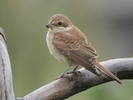search
classification
|
basic information
|
Red-backed Shrike
Lanius collurio (Linnaeus, 1758)

|
 male
|
|
|
2012-06-10
Mountain Rzhanaya, Chuya River, Altai Republic. |
© Sergey Pisarevskiy
|
|
Description
The Red-backed Shrike is slightly large than Sparrow. The male have rusty-brown mantle, grey crown and black mask; underparts are white pinkish tinged especially well expressed on flanks and breast. From the Great Grey and Lesser Grey Shrikes the male distinguishes by the intensive rusty-brown mantle; from the Brown, Turkestan and Isabelline Shrikes by the clear grey crown and black-white tail; from the Long-tailed Shrike by the shorter tail. The autumn plumage is generally similar on the spring one. The female coloring is variable; some females are almost as bright as males; but mostly female is grayish-brown above and brownish-white with brown scaly pattern below. Juveniles are similar on female but differ by the scaly pattern on the mantle. This pattern is kept after the summer (in August) molting. The main difference from the juvenile Turkestan Shrikes is the presentation of white on tail feathers. Weight 25-38 grams, length 18-21, wing 8,4-9,9, wingspan 28-31 cm.
Biology
The Red-backed Shrike is a common, in some areas rare, breeding migrant. Inhabits thickets in meadows, bushes near burnt areas, river banks and lake shores; light deciduous forest with clearings in flood plains; gardens, groves and forest belts on planes and in mountains up to 1500-1700 m in Altai. During migration occurs in reed beds. Arrives late in April to early May in small groups of 5 to 7 birds. Last migrants recorded end of May. Pairs breed 100-300 m one from the others. Nest is built up to 2 m from the ground in a bush (honeysuckle, dog-rose, buck thorn) or small tree (elm, willow, maple), but in steppe areas may be found on the ground or close to the ground in wormwood (Artemisia sp.). Both partners build the nest for 4-5 days, of thin twigs, dry grass stems and rootlets, lining with thin grass, vegetation fluff and grass heads. Clutches of 3-7 eggs (often 5-7 eggs) are found from late May to early July. Only female incubates for 12-14 days, while the male feeds her. Both parents raise the young, who fledge at 11-15 days, in late June to mid July. Repeated breeding after loss of first nest is common. Broods separate 18-25 days after fledging. Autumn migration occurs mainly in August, last birds recorded mid to late September.
References














